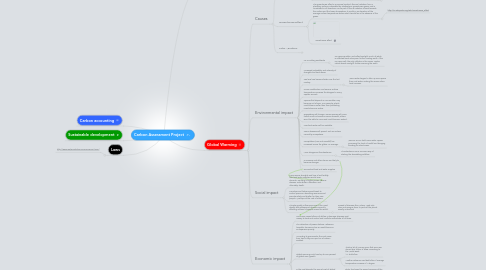
1. Carbon accounting
2. Sustainable development
3. Laws
3.1. http://www.reglementation-environnement.com/
4. Service Valorisation Responsabilité / SVR
4.1. Service
4.2. Valorisation
4.3. Responsabilité
5. Global Warming
5.1. Causes
5.1.1. Greenhouse Gases
5.1.1.1. A greenhouse gas (sometimes abbreviated GHG) is a gas in an atmosphere that absorbs and emits radiation within the thermal infrared range. This process is the fundamental cause of the greenhouse effect.[1] The primary greenhouse gases in the Earth's atmosphere are water vapour, carbon dioxide, methane, nitrous oxide, and ozone.
5.1.1.1.1. http://en.wikipedia.org/wiki/Greenhouse_gas
5.1.2. Greenhouse Effect
5.1.2.1. The greenhouse effect is a process by which thermal radiation from a planetary surface is absorbed by atmospheric greenhouse gases, and is re-radiated in all directions. Since part of this re-radiation is back towards the surface and the lower atmosphere, it results in an elevation of the average surface temperature above what it would be in the absence of the gases.
5.1.2.1.1. http://en.wikipedia.org/wiki/Greenhouse_effect
5.1.2.2. Greenhouse Effect
5.1.3. Solar Variation
5.1.3.1. Solar variation is the change in the amount of radiation emitted by the Sun (see Solar radiation) and in its spectral distribution over years to millennia. These variations have periodic components, the main one being the approximately 11-year solar cycle (or sunspot cycle). The changes also have aperiodic fluctuations.[1] In recent decades, solar activity has been measured by satellites, while before it was estimated using 'proxy' variables. Scientists studying climate change are interested in understanding the effects of variations in the total and spectral solar irradiance on Earth and its climate.
5.1.3.1.1. http://en.wikipedia.org/wiki/Solar_variation
5.2. Environmental impact
5.2.1. Ice is melting worldwide
5.2.1.1. Ice caps are white, and reflect sunlight, much of which is reflected back into space, further cooling Earth. If the ice caps melt, the only reflector is the ocean. Darker colors absorb sunlight, further warming the Earth.
5.2.2. Increased probability and intensity of droughts and heat waves
5.2.3. Sea level rise became faster over the last century.
5.2.3.1. Warm water begins to take up more space than cool water, making the sea’s surface level increase.
5.2.4. Ocean acidification and warmer surface temperatures increase the dangers to many aquatic animals
5.2.5. Species that depend on one another may become out of sync. For example, plants could bloom earlier than their pollinating insects become active.
5.2.6. Ecosystems will change—some species will move farther north or become more successful; others won’t be able to move and could become extinct.
5.2.7. Less fresh water will be available.
5.2.8. Some diseases will spread, such as malaria carried by mosquitoes.
5.2.9. Precipitation (rain and snowfall) has increased across the globe, on average.
5.2.9.1. Warmer air can hold more water vapour, increasing the level of rainfall and bringing flooding to inland areas.
5.2.10. More dangerous thunderstorms
5.2.10.1. Thunderstorms are a common way of starting the devastating wildfires
5.2.11. Hurricanes and other storms are likely to become stronger.
5.2.12. Diminished food and water supplies
5.3. Social impact
5.3.1. More severe droughts and loss of soil fertility, food and water supplies would soon diminish, resulting in higher prices, famine, disease, malnutrition, starvation and, ultimately, death.
5.3.2. Countries and factions would seek to control precious, dwindling resources and provide safety and shelter for their own people – perhaps at the cost of others.
5.3.3. Climate greatly influences some of the most deadly and widespread diseases currently affecting millions of people across the world.
5.3.3.1. Spread of diseases like Malaria, West Nile virus and Dengue fever to parts of the planet usually untouched
5.4. Economic impact
5.4.1. Hurricanes cause billions of dollars in damage, diseases cost money to treat and control and conflicts exacerbate all of these.
5.4.2. The relocation of power stations, refineries, hospitals, homes and so on would become an expensive priority.
5.4.3. According to economists, the cost varies from two to fifty euro per ton of carbon emitted.
5.4.4. Global warming could cost up to one percent of global GDP growth.
5.4.4.1. That’s a lot of money, given that GDP was almost $70 trillion in 2008, according to the World Bank : >> $7k billion
5.4.4.2. Another reference said $2k billion if average temperature increase of 1 degree
5.4.5. In the next decade, the annual cost of global warming will hit $150bn a year
5.4.5.1. That's five times the annual earnings of the entire population of Nigeria.
5.4.6. At a global scale, bleaching all the roofs would save 44 billion tonnes of CO2 due to the amount of energy reflected back into space would reduce the warming in the form of infrared radiation.
5.4.7. Replacing 20% of business trips with videoconferences would achieve annual savings of about 25 million tonnes CO2 equivalent.
